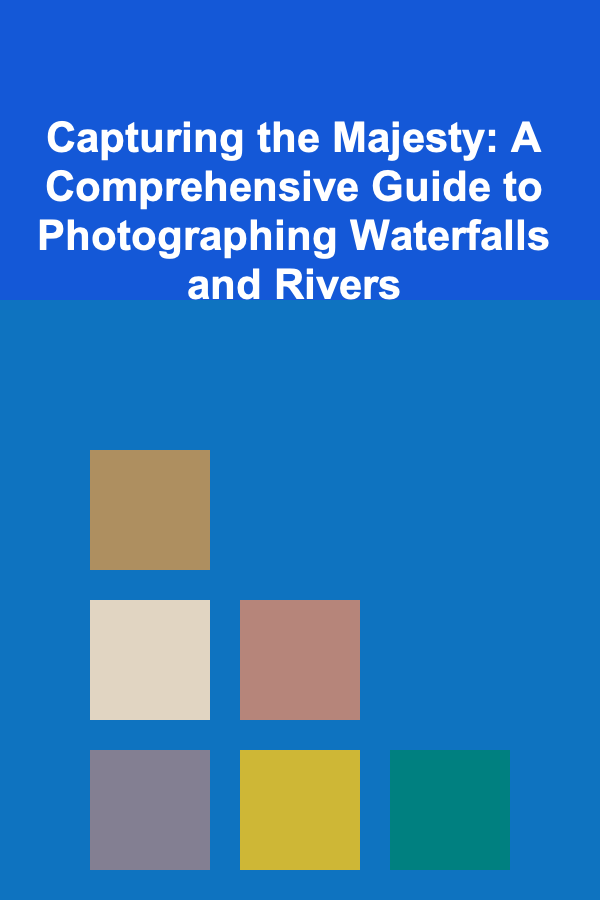
Capturing the Majesty: A Comprehensive Guide to Photographing Waterfalls and Rivers
ebook include PDF & Audio bundle (Micro Guide)
$12.99$6.99
Limited Time Offer! Order within the next:

Waterfalls and rivers offer incredible opportunities for photographers to capture the raw beauty and dynamic energy of nature. From the delicate mist of a cascading waterfall to the smooth, flowing lines of a river meandering through a valley, these subjects can create stunning and evocative images. However, photographing water effectively requires careful planning, the right equipment, and a solid understanding of photographic techniques. This guide provides a comprehensive overview of how to approach photographing waterfalls and rivers, covering everything from essential gear to advanced compositional techniques.
I. Essential Gear for Water Photography
Before you even think about heading out to the nearest waterfall, ensure you have the necessary equipment. Having the right gear will significantly improve your chances of capturing professional-quality images.
A. Camera Body
While any camera with manual control can be used, a DSLR or mirrorless camera offers the most flexibility and control. Key features to look for include:
- Full manual control: Allows you to precisely adjust aperture, shutter speed, and ISO.
- RAW image capture: Capturing images in RAW format retains more data, providing greater flexibility during post-processing.
- Good dynamic range: Waterfalls often present high contrast situations, so a camera with good dynamic range is crucial.
- Weather sealing: This is particularly important when shooting near water, protecting your camera from spray and moisture.
B. Lenses
The lens you choose will greatly influence the look and feel of your images. Consider the following:
- Wide-angle lens (16-35mm or similar): Ideal for capturing the grandeur of a large waterfall or a wide river landscape. Allows you to include more of the surrounding environment.
- Mid-range zoom lens (24-70mm or similar): A versatile option for capturing a variety of shots, from wider scenes to tighter compositions focusing on specific details.
- Telephoto lens (70-200mm or similar): Useful for isolating specific elements of the waterfall or river, compressing perspective, and creating a sense of depth. Also helpful for capturing details from a distance.
- Macro lens (optional): For capturing close-up details of rocks, moss, and water droplets.
C. Tripod
A sturdy tripod is absolutely essential for waterfall and river photography. Long exposures are often required to create the silky smooth water effect, and a tripod ensures your camera remains perfectly still during the exposure. Look for a tripod that is:
- Stable: Choose a tripod with sturdy legs and a secure locking mechanism. Carbon fiber tripods are lighter but can be more expensive. Aluminum tripods are a more affordable and durable option.
- Tall enough: Ensure the tripod can extend to a comfortable shooting height without needing to extend the center column, which can reduce stability.
- Weather-resistant: Look for tripods with weather-sealed components to protect them from moisture.
D. Neutral Density (ND) Filters
ND filters are crucial for achieving the smooth, ethereal look that is characteristic of waterfall photography. They reduce the amount of light entering the camera, allowing you to use longer shutter speeds even in bright daylight. Consider investing in:
- Variable ND filter: Offers adjustable light reduction, providing flexibility in various lighting conditions.
- Fixed ND filters: Available in different strengths (e.g., ND4, ND8, ND64, ND1000), each reducing light by a specific amount. Experiment with different strengths to achieve your desired effect. A 10-stop ND filter (ND1000) is a good starting point for achieving very long exposures.
E. Polarizing Filter
A polarizing filter reduces glare and reflections on water surfaces, saturates colors, and enhances contrast. It can also help to cut through haze and improve overall image clarity. Polarizing filters are particularly useful for revealing underwater details and enhancing the colors of surrounding foliage.
F. Remote Shutter Release or Timer
Using a remote shutter release or the camera's built-in timer eliminates camera shake during long exposures. This ensures the sharpest possible images.
G. Lens Cloth and Cleaning Supplies
Protecting your lenses from water spray and condensation is vital. Always carry a lens cloth, lens cleaning solution, and microfiber cloths to keep your lenses clean and clear.
H. Waterproof Bag or Backpack
Protect your camera gear from rain, splashes, and accidental submersion with a waterproof bag or backpack. Consider a bag with multiple compartments to organize your equipment efficiently.
I. Rain Cover for Your Camera
Even with weather sealing, it's wise to have a rain cover for your camera, especially if you plan on shooting in wet conditions.
II. Planning Your Shoot
Successful waterfall and river photography requires careful planning and preparation. Consider the following factors:
A. Location Scouting
Research potential locations beforehand. Online resources, hiking guides, and photography websites can provide valuable information about waterfall and river locations in your area. Look for:
- Accessibility: Ensure the location is accessible and that you are physically capable of reaching the best vantage points.
- Safety: Be aware of potential hazards such as slippery rocks, steep drops, and strong currents. Never venture into dangerous areas.
- Compositional possibilities: Look for locations that offer interesting compositions, such as unique rock formations, lush vegetation, or scenic viewpoints.
B. Time of Day
The time of day significantly impacts the lighting conditions and the overall mood of your images.
- Early morning and late afternoon: These times offer soft, diffused light that minimizes harsh shadows and highlights. The golden hour (the hour after sunrise and the hour before sunset) can provide warm, golden tones that enhance the beauty of the scene.
- Overcast days: Overcast days provide even, diffused light that is ideal for waterfall photography. The soft light reduces contrast and allows you to capture details in both the highlights and shadows.
- Midday: Avoid shooting during midday when the sun is high in the sky. The harsh light can create strong shadows and blow out highlights. If you must shoot during midday, look for shaded areas or use a polarizing filter to reduce glare.
C. Weather Conditions
Weather plays a crucial role in waterfall and river photography. Check the weather forecast before heading out and be prepared for changing conditions.
- Rain: While rain can make shooting more challenging, it can also create dramatic and atmospheric images. Use a rain cover to protect your camera and lenses.
- Fog and mist: Fog and mist can add a sense of mystery and drama to your images. They can also soften the light and create a dreamy atmosphere.
- Sunshine: While sunshine can be beautiful, it can also create harsh shadows and highlights. Try to shoot during the golden hour or on overcast days to avoid harsh lighting.
D. Water Flow
The water flow rate can significantly affect the appearance of the waterfall or river. Consider the following:
- High flow: High flow rates can create dramatic and powerful images, but they can also make it difficult to control the exposure.
- Low flow: Low flow rates can create a more serene and peaceful atmosphere. They can also reveal interesting rock formations and underwater details.
III. Camera Settings and Techniques
Mastering the right camera settings is crucial for capturing stunning waterfall and river images.
A. Shooting Mode
Shoot in manual mode (M) to have complete control over aperture, shutter speed, and ISO. This allows you to fine-tune your settings to achieve the desired effect.
B. Aperture
The aperture controls the depth of field, which is the area of the image that is in focus. For waterfall and river photography, you typically want a deep depth of field to ensure that the entire scene is sharp. Start with an aperture of f/8 or f/11 and adjust as needed.
- f/8 - f/11: A good starting point for landscapes. Offers a good balance between sharpness and depth of field.
- f/16 - f/22: Use these smaller apertures if you need even greater depth of field, but be aware that they can introduce diffraction, which can slightly soften the image.
C. Shutter Speed
The shutter speed controls the amount of time the camera's sensor is exposed to light. For waterfall and river photography, longer shutter speeds are typically used to create the smooth, silky water effect. Experiment with different shutter speeds to achieve your desired look.
- 1/2 second - 2 seconds: Creates a subtle blurring effect, ideal for capturing the movement of the water while still retaining some detail.
- 2 seconds - 30 seconds or longer: Creates a smooth, dreamy effect, blurring the water into a soft, flowing mass. This is the most common technique for waterfall photography. The exact shutter speed will depend on the speed of the water and the lighting conditions.
Remember to use a tripod for shutter speeds longer than 1/60th of a second to avoid camera shake.
D. ISO
Keep the ISO as low as possible (typically ISO 100) to minimize noise and maximize image quality. Use ND filters to reduce the amount of light entering the camera, allowing you to use longer shutter speeds even at low ISO settings.
E. Focusing
Accurate focusing is crucial for sharp images. Use autofocus (AF) to focus on a prominent element in the scene, such as a rock or a tree. Then, switch to manual focus (MF) to lock the focus and prevent the camera from refocusing during the exposure. Consider using back-button focusing for more control.
F. Metering
Waterfalls and rivers often present high contrast situations, which can trick the camera's meter. Use spot metering to measure the light from a specific area of the scene, such as a rock or a tree. Then, adjust your exposure settings accordingly. Alternatively, use highlight metering and then bring up the shadows in post-processing.
G. White Balance
Set the white balance to "cloudy" or "shade" to warm up the colors and create a more pleasing image. You can also adjust the white balance in post-processing.
Tip: Experiment with different shutter speeds to see how they affect the appearance of the water. A faster shutter speed will freeze the motion of the water, while a slower shutter speed will create a smooth, blurred effect.
IV. Compositional Techniques
A strong composition is essential for creating compelling waterfall and river images. Consider the following techniques:
A. The Rule of Thirds
Divide the frame into nine equal parts using two horizontal and two vertical lines. Place key elements of the scene along these lines or at their intersections to create a more balanced and visually appealing composition. For example, you might place the horizon line along the top or bottom horizontal line, or position the waterfall along one of the vertical lines.
B. Leading Lines
Use leading lines, such as rivers, streams, or paths, to guide the viewer's eye through the scene and towards the main subject. Leading lines can create a sense of depth and perspective.
C. Framing
Use natural elements, such as trees, rocks, or arches, to frame the waterfall or river. Framing can add depth and interest to the image and draw the viewer's attention to the main subject.
D. Foreground Interest
Include interesting elements in the foreground, such as rocks, moss, or flowers, to add depth and texture to the image. A strong foreground can create a sense of scale and draw the viewer into the scene.
E. Perspective
Experiment with different perspectives to find the most compelling composition. Try shooting from a low angle to emphasize the height of the waterfall, or from a high angle to capture a wider view of the landscape.
F. Symmetry and Patterns
Look for symmetrical patterns or repeating elements in the scene, such as reflections in the water or patterns in the rock formations. Symmetry and patterns can create a sense of balance and harmony.
G. Negative Space
Use negative space (empty areas in the image) to create a sense of balance and to emphasize the main subject. For example, you might leave a large area of sky above the waterfall to create a sense of openness and freedom.
H. Capture the Details
Don't just focus on the grand scale of the waterfall or river. Look for interesting details, such as textures, patterns, and colors. Capture close-up shots of rocks, moss, water droplets, and other elements to add depth and interest to your portfolio.
Warning: Be mindful of your surroundings when composing your shot. Never venture into dangerous areas or disrupt the natural environment. Practice Leave No Trace principles.
V. Post-Processing
Post-processing is an essential part of waterfall and river photography. Use software like Adobe Lightroom or Photoshop to enhance your images and bring out their full potential.
A. Basic Adjustments
Start with basic adjustments, such as:
- Exposure: Adjust the overall brightness of the image.
- Contrast: Adjust the difference between the highlights and shadows.
- Highlights and Shadows: Recover details in the highlights and shadows.
- Whites and Blacks: Set the white and black points to ensure a full tonal range.
B. Color Correction
Adjust the white balance, vibrance, and saturation to enhance the colors in the image. Pay particular attention to the blues and greens in the water and surrounding foliage.
C. Sharpening
Sharpen the image to enhance details and improve clarity. Use masking to apply sharpening selectively to specific areas of the image, such as rocks and trees, while avoiding over-sharpening the water.
D. Noise Reduction
If your image contains noise, use noise reduction to reduce it. Be careful not to over-reduce noise, as this can soften the image.
E. Graduated Filters
Use graduated filters to adjust the exposure in specific areas of the image. For example, you might use a graduated filter to darken the sky and bring out details in the clouds.
F. Healing and Cloning
Use the healing brush or clone stamp tool to remove distractions from the image, such as dust spots, power lines, or unwanted objects.
G. Local Adjustments
Use local adjustment brushes to make targeted adjustments to specific areas of the image. For example, you might use a brush to brighten a dark area or to saturate the colors in a specific object.
H. Convert to Black and White
Consider converting your image to black and white to create a dramatic and timeless look. Black and white images can emphasize the textures and tones in the scene, and they can also create a sense of mood and atmosphere.
VI. Advanced Techniques
Once you've mastered the basics, you can explore more advanced techniques to elevate your waterfall and river photography.
A. Focus Stacking
Focus stacking involves taking multiple images of the same scene with different focus points and then combining them in post-processing to create an image with a greater depth of field than is possible with a single shot. This technique is particularly useful for macro photography or for landscapes where you want to ensure that everything from the foreground to the background is in sharp focus.
B. HDR (High Dynamic Range) Photography
HDR photography involves taking multiple images of the same scene with different exposure settings and then combining them in post-processing to create an image with a wider dynamic range than is possible with a single shot. This technique is useful for high contrast scenes, such as waterfalls with bright skies and dark shadows.
C. Time-Lapse Photography
Time-lapse photography involves taking a series of photographs over a period of time and then combining them into a video to create the illusion of accelerated motion. This technique can be used to capture the changing light and movement of the water over time.
D. Using Drones for Aerial Photography
Drones offer a unique perspective for capturing waterfalls and rivers. Aerial photography can reveal hidden landscapes, dramatic viewpoints, and interesting patterns in the water flow. Ensure you follow all local regulations and safety guidelines when flying a drone.
VII. Safety Considerations
Safety should always be your top priority when photographing waterfalls and rivers.
- Wear appropriate footwear: Wear sturdy hiking boots with good traction to prevent slipping on wet rocks.
- Be aware of your surroundings: Be mindful of slippery rocks, steep drops, and strong currents. Never venture into dangerous areas.
- Check the weather forecast: Be prepared for changing conditions and avoid shooting during storms or floods.
- Tell someone where you are going: Let someone know your planned route and estimated return time.
- Bring a first-aid kit: Be prepared for minor injuries.
- Respect the environment: Practice Leave No Trace principles. Pack out everything you pack in and avoid disturbing the natural environment.
- Watch out for wildlife: Be aware of the potential presence of wildlife, such as snakes, bears, and insects.
VIII. Conclusion
Photographing waterfalls and rivers is a rewarding and challenging endeavor. By understanding the principles of composition, mastering the right camera settings, and prioritizing safety, you can capture stunning images that showcase the beauty and power of these natural wonders. Remember to experiment, be patient, and most importantly, have fun!

How to Choose the Best Pet Insurance for Your Pet's Needs
Read More
How to Craft a Self-Care Kit for Easy Accessibility
Read More
How to Screen Potential Tenants Effectively and Avoid Problems
Read More
How to Set Up a Checklist for Organizing Your Pantry
Read More
How To Train Your Brain for Better Decision-Making
Read More
How to Reduce Your Waste in the Bathroom
Read MoreOther Products

How to Choose the Best Pet Insurance for Your Pet's Needs
Read More
How to Craft a Self-Care Kit for Easy Accessibility
Read More
How to Screen Potential Tenants Effectively and Avoid Problems
Read More
How to Set Up a Checklist for Organizing Your Pantry
Read More
How To Train Your Brain for Better Decision-Making
Read More